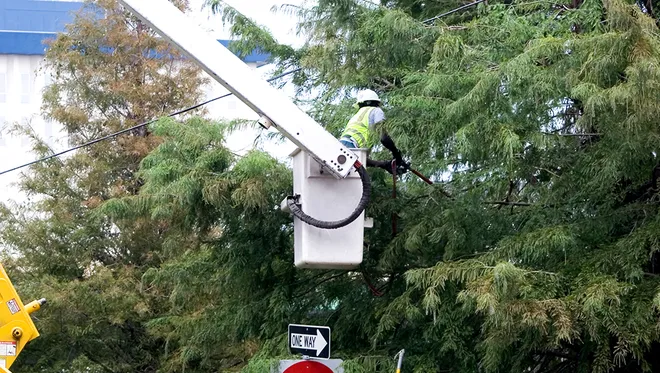Key Takeaways
- Sustainable vegetation management is critical for ensuring reliable energy delivery while minimizing environmental impact and balancing operational needs with ecological responsibility.
- Cutting-edge technologies, such as LiDAR, drones, and data analytics, enable utilities to manage vegetation with greater precision, improving both efficiency and safety.
- Environmentally conscious practices, like selective cutting, support biodiversity and help utilities reduce their carbon footprint while meeting infrastructure needs.
- Despite challenges like regulatory compliance and unpredictable weather, adaptive management approaches and collaboration with local communities offer effective solutions for sustainable vegetation control.
- Emerging technologies, including AI and machine learning, are poised to revolutionize vegetation management, offering smarter, more responsive solutions for utilities in the future.
Introduction to Vegetation Management in Utilities
In the intricate dance of delivering dependable energy, vegetation management stands as a pivotal element, ensuring that lush greenery coexists harmoniously with extensive power lines and critical infrastructure. As the global population burgeons and energy consumption surges, utility companies are tasked with the challenge of balancing robust energy distribution with environmental stewardship. This is where expert guidance in the form of vegetation management consulting comes into play. Such consulting not only presents innovative strategies for growth control but also prioritizes both safety and sustainability. By judiciously managing this crucial aspect, utilities can significantly reduce outages—a proactive measure that not only secures energy flow but underscores the sector’s commitment to eco-conscious practices.
The Role of Technology in Vegetation Management
In today’s rapidly evolving technological landscape, utilities are increasingly turning to cutting-edge innovations to refine their vegetation management practices. A standout innovation is LiDAR technology, which uses light detection and ranging to create high-resolution maps of the environment. Coupled with the agility of drones, these technologies furnish utility companies with unprecedented accuracy in assessing vegetation growth and potential hazards. Utilities can now predict and model vegetation dynamics with remarkable precision by harnessing data analytics. Such technology-driven strategies eliminate guesswork, allowing for targeted interventions that are both efficient and minimally invasive. This transformative approach not only enhances reliability but also saves time and resources. For deeper insights into these advancements, one can explore further findings shared by Utility Dive.
Environmental Benefits of Sustainable Practices
Adopting sustainable practices in vegetation management transcends the immediate goal of safety and reliability, contributing significantly to environmental conservation. Through practices that emphasize minimal disturbance and ecological preservation, utilities can diminish their carbon footprint, promoting a more sustainable interaction with nature. Selective cutting, as opposed to clear-cutting, encourages the retention of native plant life and fosters biodiversity, maintaining the natural habitat for local wildlife. This advantageous synergy of utility management and ecological mindfulness signifies a broader commitment to preserving our planet for future generations. By implementing these sustainable practices, utilities exemplify responsible environmental stewardship while still meeting their operational goals.
Challenges and Solutions in Utility Vegetation Management
The realm of utility vegetation management is not without its challenges. Factors such as regulatory compliance, diverse geographical landscapes, and the unpredictability of weather patterns create a complex web of considerations. Moreover, executing large-scale operations while minimizing impact on local communities and ecosystems can prove daunting. However, solutions lie in adaptive management approaches that blend flexibility with strategic foresight. By leveraging comprehensive data collection and analysis, utilities can craft tailored strategies that anticipate growth trends and mitigate potential issues proactively. Furthermore, fostering collaborations with local communities and experts enhances the effectiveness of management plans, ensuring both regulatory alignment and ecological sensitivity.
Economic Impacts of Efficient Vegetation Control
Beyond environmental and operational gains, efficient vegetation management delivers substantial economic benefits. By strategically managing vegetation, utility companies can significantly cut maintenance costs associated with overgrowth and reduce outage frequencies—a particular concern during seasonal weather extremes. The cost-effectiveness of these practices translates into economic efficiencies that can be redirected toward other vital areas, such as infrastructure upgrades and the integration of renewable energy sources. Furthermore, by minimizing service disruptions, utilities enhance customer satisfaction and loyalty, fortifying their market position amidst growing competition.
Case Studies: Successful Vegetation Management Programs
The effectiveness of innovative vegetation management strategies is vividly illustrated through case studies from around the globe. For example, in the Midwest, a forward-thinking utility company employed drone technology and predictive analytics, realizing a notable 30% decrease in outage times during storm seasons. This remarkable outcome underscores the power of technology-driven practices, showcasing how proactive strategies can lead to tangible improvements. By examining these success stories, other utility companies can glean insights and inspiration for their own initiatives. More details and examples can be found in a comprehensive case study overview presented by T&D World.
Future Trends in Utility Vegetation Management
The future of utility vegetation management is poised for groundbreaking transformations as emerging technologies continue to make their mark. Artificial intelligence and machine learning, in particular, hold immense promise in refining management practices. These sophisticated tools are set to revolutionize the processing and interpretation of vast datasets, enabling utilities to predict growth patterns and optimize maintenance schedules with precision. As these technologies mature, they offer a pathway toward smarter, more responsive vegetation management solutions that can seamlessly adjust to changing environmental conditions and demands. In embracing these advancements, utility companies are not only future-proofing their operations but also charting a course toward more sustainable energy management.
Conclusion
In conclusion, sustainable vegetation management practices in the utility sector are essential for balancing the demands of reliable energy delivery with environmental responsibility. The integration of cutting-edge technologies, such as LiDAR and drones, allows utilities to optimize their management strategies, enhancing safety, efficiency, and cost-effectiveness. Utilities can contribute to biodiversity preservation and reduce their carbon footprint by adopting eco-friendly methods like selective cutting, showcasing a commitment to sustainability. Despite challenges like regulatory compliance and unpredictable weather, adaptive management strategies and community collaboration offer effective solutions for maintaining a balance between infrastructure needs and environmental preservation. Looking ahead, emerging technologies like AI and machine learning promise to further refine vegetation management, ensuring that utilities can meet the needs of both today and the future with greater precision and sustainability.




